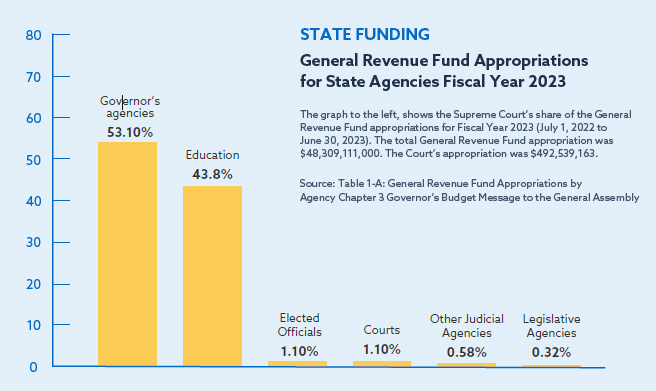State and Local Funding for the Illinois Courts | State of Illinois Office of the Illinois Courts
Financing the state court system is a shared responsibility of the state and the 102 counties of the state. Revenue to provide court services to the people of the state comes from a variety of sources: the state income tax, county property taxes, case filing fees, court-imposed fines and assessments, and other fees.
State government pays for the salaries, benefits, and office expenses of supreme and appellate court judges, and salaries and benefits of circuit court judges. Effective July 1, 2025, judicial salaries, as determined by the legislature, were: Supreme Court justices, $298,910; appellate court judges, $281,331; circuit court judges, $258,158; and associate judges, $245,250. The state also pays for support staff of supreme and appellate court judges, staff in other units of the supreme and appellate courts, a small number of other personnel in the circuit courts, and mandatory arbitration staff in several counties. Part of the cost of operating the mandatory arbitration program is offset by fees paid by participants in the program. During Calendar Year 2023, the arbitration filing and rejection fees collected amounted to $3,991,936.
State funding for probation and court services departments covers approximately 3,100 probation and court services personnel, for which the counties receive full and partial salary reimbursement on a monthly basis. The statutorily mandated full funding level was appropriated to fund eligible probation services positions. The state Judicial Branch appropriation also supports other operational and program expenses. County governments pay part of the cost of financing circuit court operations. Counties provide office and courtroom space, maintenance, and support staff to assist the circuit court judges. Circuit clerks collect money to help pay for their operations and some court operations. They also collect and disburse revenues to help fund local and state government programs.
 General Revenue Fund Appropriations for State Agencies Fiscal Year 2024
General Revenue Fund Appropriations for State Agencies Fiscal Year 2024
Local Funding
The circuit clerk’s office in each county provides a variety of court recordkeeping and financial accounting services. Circuit clerks are elected for four-year terms by the voters in each county. Circuit clerks, with help from deputy clerks, attend sessions of the court, preserve court files and papers, and maintain complete records of all cases. Employees of the clerks’ offices are appointed by and are accountable to the circuit clerk, with the county board having budgetary authority.
During 2023, the total number of full-time employees in all 102 circuit clerk offices was 3,162, assisted by a total of 133 part-time employees. The cost of operating all circuit clerks’ offices totaled $239,077,063 in 2023.
Revenue to pay for these court-related services comes primarily from property taxes, filing fees, and court-ordered fines and costs. Fines, fees and other costs collected by circuit clerks are governed primarily by statute and Supreme Court rule.
Revenue to Finance Local Improvements
Fees and court-ordered fines were collected in 2023 by circuit clerks and earmarked for improvements in the clerks’ offices and to help defray the cost to the county of operating the courts at the local level.
|
|
|
Court Document Storage Fund:
is used for any costs relative to the storage of court records.
|
$20,161,146
|
Court Automation Fund:
is used to establish and maintain automated systems for keeping court records.
|
$19,835,199
|
County Law Library Fund:
helps defray the costs of maintaining a law library in the county for judges, attorneys, and the public.
|
$8,104,129
|
County Fund To Finance the Court System:
is available from fees collected by circuit clerks to help finance the court system in the county.
|
$5,420,143
|
Circuit Court Clerk Operations and Administrative Fund:
is used to offset costs incurred for collection and disbursement of State and local funds.
|
$7,933,452
|
Uncollected Claims
The Administrative Office, the Supreme Court Clerk, the Supreme Court Library, and the Clerks of the five Appellate Districts are responsible for collecting certain fees. Outstanding accounts receivable are normally collected by the unit to which the account is owed. Additionally, a small number of accounts receivable are turned over to the State Comptroller’s offset system. At the end of FY23, there were 6 claims due and payable, totaling $12,989.82.
Revenue to Finance Other Programs
In addition to collecting fees for local improvements, circuit clerks receive, account for, and distribute millions of dollars to county governments, various local governmental entities, and various state funds. Some of the programs and dollars collected in 2023 by circuit clerks are listed below:
|
|
|
Child Support and Maintenance:
Court ordered payments collected and distributed by Circuit Clerks and the State Disbursement Unit.
|
$941,778,151
|
Drug Treatment Fund:
Court ordered drug assessments are used to pay for treatment programs for people addicted to alcohol, cannabis, or controlled substances.
|
$3,887,614
|
Violent Crime Victims Assistance:
Court ordered penalties in criminal and certain traffic cases are used to support victim and witness assistance centers throughout the state.
|
$4,689,136
|
Trauma Center Fund:
Fees collected in certain traffic, DUI, and criminal cases are used to support Illinois hospitals that are designated as trauma centers.
|
$1,745,704
|
Traffic and Criminal Conviction Surcharge:
An additional penalty imposed in traffic and criminal cases is used for training of law enforcement and correctional officers.
|
$6,151,299
|
Drivers Education Fund:
Penalties and forfeitures in offenses reportable to the Secretary of State are used for driver education programs in high schools.
|
$1,619,014
|